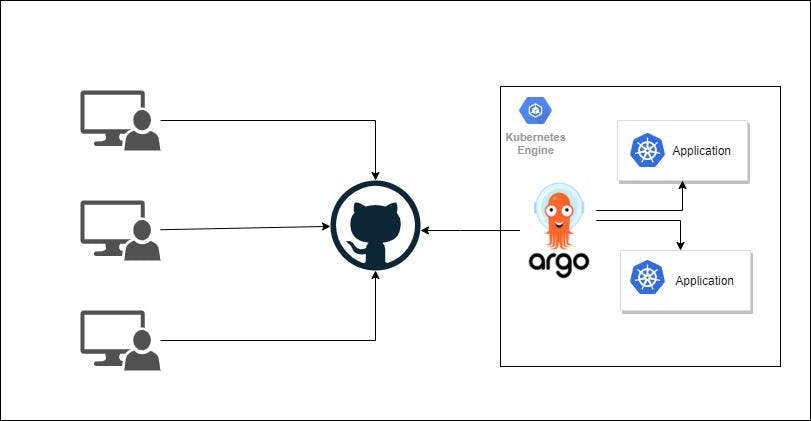GitOps and Argo CD: A Beginner's Guide
GitOps is a modern approach to managing software delivery using Git as the single source of truth. It helps teams to simplify and automate the software development life cycle (SDLC) and achieve continuous delivery. Argo CD is an open-source GitOps tool that provides declarative continuous delivery for Kubernetes-based applications.
In this article, we'll explore what GitOps and Argo CD are, how they work, and their benefits.
What is GitOps?
GitOps is a methodology for managing the SDLC that uses Git as the source of truth for all changes. It means that all changes, including configuration changes, infrastructure changes, and code changes, are made through Git. The Git repository becomes the central hub for all changes and acts as the single source of truth for the system.
The core idea behind GitOps is to automate the deployment process using Git-based workflows. The GitOps workflow includes the following steps:
Developers make changes to the code or configuration files and push them to the Git repository.
The Git repository triggers an event to the CI/CD pipeline to build, test, and deploy the changes.
The CI/CD pipeline deploys the changes to the target environment, such as development, staging, or production.
The GitOps tool monitors the target environment and ensures that the actual state matches the desired state defined in the Git repository.
By using GitOps, teams can reduce the time and effort required to deploy applications and infrastructure. It also improves collaboration between developers, operations teams, and other stakeholders, as all changes are visible and auditable in Git.
What is Argo CD?
Argo CD is an open-source GitOps tool that provides declarative continuous delivery for Kubernetes-based applications. It automates the deployment process using Git-based workflows and ensures that the target environment's actual state matches the desired state defined in the Git repository.
Argo CD works by using Kubernetes manifests and Helm charts to deploy applications to a Kubernetes cluster. It provides a web interface and a command-line interface (CLI) for managing applications and environments. Argo CD supports a wide range of Git repositories, including GitHub, GitLab, and Bitbucket.

How does Argo CD work?
Argo CD works by using a declarative approach to deploy applications to a Kubernetes cluster. It means that the desired state of the application is defined in the Git repository using Kubernetes manifests or Helm charts. Argo CD then reconciles the actual state of the application with the desired state and ensures that they match.
The key components of Argo CD are:
The Argo CD server: It is the core component of Argo CD that runs on a Kubernetes cluster and provides the web interface and CLI for managing applications and environments.
The Argo CD agent: It runs on each Kubernetes cluster and reconciles the actual state of the application with the desired state defined in the Git repository.
The Argo CD application defines the desired state of the application using Kubernetes manifests or Helm charts.
The Argo CD project: It defines the scope of the application and the permissions required to access it.
Argo CD uses a push and pull-based model to manage the deployment of applications to Kubernetes clusters. Let's take a closer look at what these models entail:
Push-based model: In a push-based model, changes are pushed from the development environment to the production environment. This model is common in traditional development workflows, where developers make changes to code and push them to a version control system, and then an operations team deploys the changes to a production environment. In Argo CD, the push-based model is used when changes are made directly to the Kubernetes cluster. When changes are made in the cluster, they are detected by Argo CD and synced with the desired state defined in the Git repository.
Pull-based model: In a pull-based model, changes are pulled from a version control system and deployed to a production environment. This model is used in GitOps workflows, where changes to the desired state of an application are made in a Git repository, and then Argo CD pulls those changes and applies them to the Kubernetes cluster. In the pull-based model, Argo CD periodically checks the Git repository for changes and updates the cluster to match the desired state.
Argo CD supports both push and pull-based models, which makes it flexible and adaptable to different development workflows. The push-based model is useful for making quick changes directly to the cluster, while the pull-based model is ideal for managing complex changes and ensuring that the actual state of the cluster matches the desired state defined in Git.
What are the benefits of using Argo CD?
Argo CD offers several benefits for teams that want to adopt GitOps and automate the deployment process. Some of the key benefits include:
Simplified deployment process: Argo CD simplifies the deployment process by using a declarative approach to define the desired state of the application.
Continuous delivery: Argo CD provides continuous delivery for Kubernetes-based applications and ensures that the actual state matches the desired state.
Scalability: Argo CD is highly scalable and can manage multiple applications and environments at the same time.
Improved collaboration: Argo CD improves collaboration between developers and operations teams.
Automated rollbacks: Argo CD provides automated rollbacks in case of a deployment failure. It can roll back to the previous stable version of the application and notify the team about the failure.
Customizable deployment strategies: Argo CD supports a wide range of deployment strategies, including canary, blue-green, and rolling updates. This allows teams to choose the deployment strategy that best suits their needs and goals.
In summary, Argo CD is an open-source GitOps tool that provides declarative continuous delivery for Kubernetes-based applications. It simplifies the deployment process, provides continuous delivery, is highly scalable, improves collaboration, provides automated rollbacks, and supports customizable deployment strategies.
